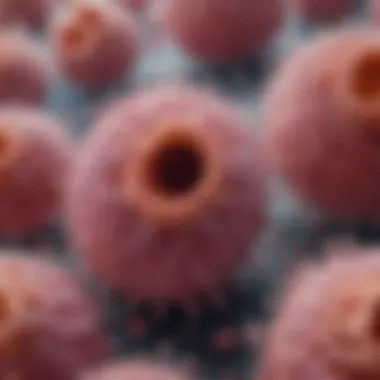Intraductal Prostate Cancer Treatment: A Comprehensive Exploration


Intro
Intraductal prostate cancer is a distinctly challenging manifestation of prostate malignancies that presents both diagnostic and therapeutic hurdles. Understanding this condition requires a grasp of its unique characteristics and clinical implications, as well as an appreciation for the variety of treatment options available. This section serves as an entry point into the significance of addressing intraductal prostate cancer effectively, based on recent advances in research and ongoing medical practice.
Research Highlights
Overview of Key Findings
Recent studies have brought to light several crucial aspects of intraductal prostate cancer. One of the standout findings is the correlation between intraductal carcinoma and more aggressive clinical behavior. This underscores the need for rigorous screening and monitoring techniques, as early detection may significantly influence patient outcomes.
Moreover, the exploration of treatment modalities has shown that approaches involving both established and emerging therapies can lead to improved efficacy. These treatments range from conventional surgical methods to novel options such as targeted therapies, depending on the cancer's specific characteristics.
Significance of the Research
The research surrounding intraductal prostate cancer is vital for multiple reasons. First, the complexity of this disease necessitates comprehensive understanding not just for urologists, but all healthcare professionals involved in oncology. Furthermore, the advancements in medical technology and pharmacology today drive the potential for personalized treatment plans, adapting to individual patient needs based on genetic and molecular profiling.
"The landscape of intraductal prostate cancer treatment is evolving, with precision medicine taking a front seat."
Treatment Options
Various treatment options are available for intraductal prostate cancer. These include:
- Watchful Waiting or Active Surveillance: Ideal for less aggressive forms of the disease. It involves closely monitoring the cancer without immediate intervention.
- Radical Prostatectomy: A surgical option that removes the prostate gland and surrounding tissue, indicated for cases where intervention is necessary.
- Radiation Therapy: This includes external beam radiation or brachytherapy, often used in conjunction with other treatments.
- Hormonal Therapy: This aims to lower hormone levels that might fuel cancer growth, applicable in more advanced cases.
- Chemotherapy and Targeted Therapies: These are now being explored as adjuncts to standard care, fostering a more targeted attack on cancer cells.
The discussion around these options is crucial as it reaffirms the idea that treatment should be personalized, taking into account the patient's unique condition, general health, and preferences.
End
In summary, understanding intraductal prostate cancer is essential for developing effective treatment strategies. As research continues to unfold, integration of new findings into clinical practice will likely enhance patient care, making it even more critical for healthcare professionals to stay informed about the latest developments. The implication of precision medicine, along with traditional therapies, points towards a future where treatment regimens can be tailored to the individual, improving outcomes in this challenging area of oncology.
Understanding Intraductal Prostate Cancer
Understanding intraductal prostate cancer is crucial for both diagnosis and treatment decisions. This form of prostate cancer presents unique challenges that differentiate it from other types. Examining its specific aspects allows healthcare professionals to implement a suitable treatment strategy.
Definition and Characteristics
Intraductal prostate cancer is identified as a variant of prostate cancer, primarily due to its unique growth patterns and histological features. It arises within the ducts of the prostate gland, often detected through biopsy. This condition is characterized by the presence of cancerous cells filling the ducts, leading to obstructed pathways.
Unlike more common forms of prostate cancer, intraductal cancer may remain localized for an extended period. However, it carries a higher risk of progression. It can represent a significant challenge in prognosis and treatment, requiring specialized knowledge from medical professionals.
Epidemiology and Risk Factors
The epidemiology of intraductal prostate cancer reveals a complex interplay of various factors. Studies indicate that this form of cancer tends to affect older men, generally those over the age of 60. Risk factors also include
- Family history: A strong familial link is observed.
- Ethnicity: African American men are disproportionately affected compared to Caucasian men.
- Diet: Diets high in fats may increase the risk.
Understanding these factors helps in identifying patients at risk. Regular screenings and knowledge about family history can lead to earlier diagnosis and better outcomes.
Pathophysiology of Intraductal Cancer
The pathophysiology of intraductal prostate cancer is complex. The cancer begins in the prostate ducts, with malignant cells proliferating and disrupting normal tissue. As the disease progresses, it can invade surrounding tissues, leading to metastasis.
Genetic alterations are also involved. Changes in oncogenes and tumor suppressor genes contribute to the malignant transformation of prostate cells. This process highlights the need for ongoing research into the genetic underpinnings of the disease.
"A profound understanding of the pathophysiology is key to developing targeted therapies."


Clinical Presentation and Diagnosis
Understanding the clinical presentation and diagnosis of intraductal prostate cancer is critical in establishing effective treatment strategies. Patients often present with nuanced symptoms, which can significantly affect the diagnosis and management of the disease. Early and accurate identification aids in the timely initiation of treatment, potentially improving outcomes. Moreover, this area connects directly to how healthcare professionals assess and proceed with treatment options available for this specific cancer type.
Symptoms and Signs
Symptoms of intraductal prostate cancer may not be overt at first. Many patients do not experience symptoms until the disease progresses. However, some common signs can include:
- Urinary difficulties: This can manifest as a weak urine flow, difficulty starting or stopping urination, or the need to urinate more frequently, especially during nighttime.
- Pelvic pain: Discomfort in the pelvic area is a potential indicator.
- Blood in urine: Hematuria might occur in advanced cases, raising suspicion for malignancy.
- Sexual dysfunction: Issues like erectile dysfunction or painful ejaculation may surface.
These symptoms can overlap with benign prostatic hyperplasia or prostatitis, complicating initial evaluations. Therefore, healthcare providers must maintain a high index of suspicion, particularly in high-risk populations, such as older patients or those with a family history of prostate cancer.
Diagnostic Imaging Techniques
Accurate imaging is essential in the diagnosis of intraductal prostate cancer. Several modalities provide valuable information:
- Magnetic Resonance Imaging (MRI): This non-invasive method offers detailed images of the prostate and surrounding structures. Advances in MRI technology, particularly multiparametric MRI, can help in staging and evaluating the extent of the cancer. It is also useful in guiding biopsy procedures.
- Computed Tomography (CT) Scans: While not the first choice for localized prostate cancer, CT scans can be useful in assessing the spread of the disease to lymph nodes and other organs.
- Ultrasonography: Transrectal ultrasound (TRUS) is commonly used for guiding biopsy and assessing prostate size and shape.
Each imaging technique provides different insights, enabling a comprehensive evaluation that is crucial for accurate diagnosis.
Biopsy Procedures and Histopathological Assessment
Biopsy remains the gold standard for definitive diagnosis of intraductal prostate cancer. In this process, a small tissue sample is obtained from the prostate for microscopic examination. Several methods exist:
- Transrectal ultrasound-guided biopsy (TRUS): This is the most common approach, where the ultrasound assists in targeting specific areas of the prostate.
- Saturation biopsy: This involves taking multiple samples to improve detection rates, especially in cases suspected of being more aggressive.
Histopathological assessment is critical. Pathologists evaluate the tissue samples for cancer characteristics, including:
- Gleason score: This grading system assesses the aggressiveness of the tumor.
- Architectural patterns: Different growth patterns can indicate the likelihood of the cancer spreading.
Effective diagnosis using biopsy techniques lays the foundation for tailoring treatment plans that best address the individual patient’s needs and cancer stage.
Treatment Modalities for Intraductal Prostate Cancer
The treatment modalities for intraductal prostate cancer are essential for understanding how to manage this unique form of malignancy. Treatment options can vary widely based on the cancer stage, patient health, and preferences. Knowledge of the different treatment approaches aids healthcare professionals in making informed decisions that prioritize patient outcomes. This discussion includes a range of traditional therapies, such as surgery and radiation, as well as emerging treatments that leverage advances in medical science.
Active Surveillance
Active surveillance is a common strategy for men with low-risk intraductal prostate cancer. This approach involves closely monitoring the patient's condition without immediate intervention. Regular check-ups typically include PSA testing, digital rectal exams, and possibly repeat biopsies. The goal is to avoid unnecessary treatments that may have significant side effects while remaining vigilant about any changes in the cancer's progression. This method provides many patients with a quality of life free from the burden of aggressive treatments that may not be needed for indolent disease.
Surgical Options
Surgery is one of the primary modes of treatment for localized intraductal prostate cancer. The most common surgical procedure is radical prostatectomy, where the prostate gland and some surrounding tissue are removed. This approach can be particularly effective if the cancer is confined to the prostate and has not spread. Side effects, including changes in urinary function and sexual health, are important considerations with surgical options. Therefore, a thorough discussion about the risks and benefits is necessary for informed consent.
Radiation Therapy
Radiation therapy can be used as a curative treatment for intraductal prostate cancer, particularly in patients who are not surgical candidates or those who prefer to avoid surgery. This treatment employs high-energy rays to target and kill cancer cells. Two main types exist: external beam radiation therapy and brachytherapy. External beam involves directing radiation from outside the body, while brachytherapy entails placing radioactive seeds inside or near the tumor. Each has distinct advantages and disadvantages that must be discussed in the context of the patient's health and cancer characteristics.
Hormonal Therapy
Hormonal therapy aims to reduce androgen levels, which can fuel prostate cancer growth. This modality is particularly useful for advanced forms of prostate cancer but can also be integrated early in treatment for intraductal variants that exhibit aggressive features. Options include medications that block testosterone production or the effect of testosterone on cancer cells. Side effects, such as hot flashes, weight gain, and mood changes, are important factors that need consideration in a patient-centered treatment plan.
Chemotherapy
Chemotherapy is generally reserved for advanced or resistant cases of intraductal prostate cancer, especially when hormonal therapy is no longer effective. This treatment uses drugs to kill rapidly dividing cancer cells. It's administered in cycles and can be effective in controlling symptoms and extending survival. However, the side effects can be quite severe and often include fatigue, hair loss, and susceptibility to infections. Thus, discussing the potential benefits versus the quality of life impact is critical.


Emerging Treatments and Clinical Trials
The landscape for treating intraductal prostate cancer is evolving, with a rich field of emerging treatments and clinical trials. Novel therapies, including immunotherapy and targeted therapy, are being researched to offer more effective options with fewer side effects. Participation in clinical trials can provide patients access to cutting-edge treatments that may not yet be widely available. Health providers should stay updated on the latest research findings and actively discuss with patients the possibility of trial participation as an option for their treatment plan.
Multidisciplinary Approach to Treatment
In the context of intraductal prostate cancer treatment, a multidisciplinary approach proves essential for optimizing patient outcomes. This method leverages the expertise of various healthcare professionals, ensuring a comprehensive strategy that addresses the complexities of this cancer type.
A coordinated effort among urologists, oncologists, nurses, and allied health professionals creates a more holistic treatment plan. This collaboration facilitates better communication, which can mitigate risks of misinformation and improve patient education about their condition and treatment options. The involvement of different specialists can also enhance the personalization of care, taking into account the unique needs of each patient.
Role of Urologists
Urologists are often the first line of defense in the diagnosis and initial management of intraductal prostate cancer. Their responsibilities encompass a range of practices, including conducting physical examinations, ordering diagnostic imaging, and interpreting biopsy results. Urologists play a crucial role in determining whether a patient requires active surveillance or intervention.
Moreover, during treatment, they are tasked with performing surgical options when indicated. Their expertise is vital in executing procedures effectively, ensuring that the patient receives the best possible care. Urologists also provide ongoing reviews of patient progress, taking action when necessary to adjust treatment plans based on the patient’s response.
Oncologist's Perspective
Oncologists bring a different perspective to the table, focusing on the systemic aspects of cancer care. Their role is significant in recommending specific treatment regimens such as chemotherapy or hormonal therapy. Oncologists assess the effectiveness of treatment through regular evaluations and adapt the approach based on the patient’s changing condition and advancements in research findings.
Additionally, oncologists often lead discussions about the possible side effects of treatments like radiation therapy. Their insights help patients make informed decisions regarding their care. With an emphasis on both survival and quality of life, oncologists aim to tailor treatment plans effectively, implementing evidence-based strategies to maximize positive outcomes.
Support from Nursing and Allied Health Professionals
Support from nursing and allied health professionals is a cornerstone of the multidisciplinary approach. Nurses perform vital roles in patient education, symptom management, and emotional support. They play a key role in monitoring the patient’s reactions to treatment, offering guidance on coping strategies, and providing resources for additional help.
Allied health professionals, including dietitians, social workers, and physical therapists, contribute by addressing the broader challenges that patients face. For example, dietitians can provide nutritional advice to maintain the patient's health and energy levels during treatment. Similarly, social workers can aid in navigating healthcare systems, ensuring that the patient receives the full spectrum of necessary support services, including financial counseling.
Patient Outcomes and Quality of Life
Intraductal prostate cancer presents unique challenges that directly affect patient outcomes and quality of life. Understanding these aspects is essential for healthcare professionals involved in the treatment and management of this condition. Positive patient outcomes are not solely quantified by survival rates; rather, they encompass the overall well-being and satisfaction of the individual post-treatment. Factors such as physical health, emotional stability, and functional capabilities contribute significantly to this assessment.
Of particular importance is the survivorship experience. This experience is influenced by the effectiveness of the treatment modalities employed. As patients navigate the complexities of their condition, they must also contend with the side effects associated with various treatments. Addressing issues such as fatigue, urinary incontinence, and sexual dysfunction becomes crucial.
In this section, we will explore:
- Survival rates that vary by treatment type
- Monitoring strategies for recurrence
- The broader impact on quality of life
Each of these elements will showcase how vital it is to tailor treatment plans to individual needs, ensuring not just a focus on extending life but also enhancing the quality of that life.
Survival Rates by Treatment Type
Survival rates for intraductal prostate cancer can vary significantly depending on the treatment approach. Research has shown that:
- Patients undergoing active surveillance often report favorable long-term outcomes, primarily for those with low-risk tumors. This strategy emphasizes regular monitoring rather than immediate treatment.
- Surgical options, particularly radical prostatectomy, can lead to increased survival rates in localized cases. However, this procedure is associated with potential complications.
- Radiation therapy presents another avenue, with studies indicating that it maintains a competitive survival rate, often on par with surgery for certain patient demographics.
Assessment of these rates helps clinicians recommend appropriate interventions tailored to the specific characteristics of each patient's cancer.
Monitoring Recurrence
Monitoring for recurrence is an essential aspect of managing intraductal prostate cancer. Regular follow-up appointments and diagnostic tests, including PSA levels, imaging, and biopsies, are crucial in early detection of any resurgence of the disease. Patients should engage in open discussions with their healthcare team regarding the frequency and types of monitoring to ensure that they are comfortable with the approach.
It's vital for patients to be educated about the symptoms of recurrence. Common signs may include:
- Changes in urinary habits
- New onset of bone pain
- Unexplained weight loss


Establishing clear lines of communication between the patient and their medical team is fundamental for effective monitoring.
Impact on Quality of Life
The impact of intraductal prostate cancer treatment on quality of life cannot be overstated. Treatments may lead to several potential side effects that can diminish everyday life experiences for patients. Issues such as erectile dysfunction, changes in urinary function, and emotional health considerations contribute significantly to the overall quality of life.
Addressing these issues requires a multidimensional approach. This can involve:
- Psychological support to tackle emotional challenges stemming from the diagnosis and treatment.
- Rehabilitation services that focus on helping patients manage physical side effects.
- Educational resources to inform patients about what to expect during their treatment journey.
"The goal of treatment is not just to prolong life but to enhance the living experience of patients."
In summary, the focus on patient outcomes and quality of life in intraductal prostate cancer treatment is crucial. It must encompass a detailed understanding of survival rates, recurrence monitoring, and the holistic impact on everyday living. By doing so, both healthcare providers and patients can engage in more meaningful discussions that prioritize well-being alongside clinical efficacy.
Future Directions in Intraductal Prostate Cancer Treatment
The exploration of future directions in intraductal prostate cancer treatment is crucial for understanding how advancements in medicine can reshape patient management. With a focus on innovative strategies, this area promises to enhance treatment outcomes and personalize care.
Advances in Precision Medicine
Precision medicine is redefining the approach to cancer treatment, including intraductal prostate cancer. This method tailors therapies based on individual patient characteristics, including genetic makeup, lifestyle, and environment.
- Targeted Therapies: New drugs aim to target specific cancer pathways rather than a one-size-fits-all approach. For instance, inhibitors that focus on distinct genetic mutations found in some patients may improve effectiveness while minimizing side effects.
- Biomarkers: Research is actively identifying biomarkers that can predict treatment responses. This allows oncologists to select the most effective treatments based on the patient's specific tumor profile.
- Clinical Trials: Ongoing clinical trials are essential for testing precision medicine approaches in intraductal prostate cancer. These studies help to determine the efficacy of personalized treatments and modify standard protocols to improve patient outcomes.
The evolution of precision medicine offers significant hope. Patients may benefit from treatments that are specifically designed for their unique cancer characteristics, leading to better effectiveness and fewer side effects.
Role of Genetic Research and Biomarkers
Genetic research is pivotal in advancing treatment for intraductal prostate cancer. Understanding the genetic abnormalities that drive this disease can lead to groundbreaking treatment approaches. Biomarkers, which are biological molecules indicative of a disease, play a crucial role.
- Identification of Aggressive Forms: Research identifies genetic mutations associated with more aggressive cancer types. This can inform treatment strategies, allowing for more aggressive interventions when necessary.
- Predictive Value: Utilizing biomarkers can predict patient responses to various therapies. For example, knowing whether a tumor expresses certain proteins can guide the choice between hormone therapy or chemotherapy.
- Risk Assessment: Genetic testing also helps determine risk levels in patients. This knowledge supports surveillance strategies and informs patients about their likelihood of disease progression.
Integrating genetic research and biomarkers into clinical practice promises to transform how intraductal prostate cancer is managed, emphasizing personalized care.
The Impact of Artificial Intelligence in Diagnosis and Treatment Planning
Artificial intelligence (AI) is making inroads in oncology, providing tools that enhance both diagnosis and treatment planning. AI technologies can analyze vast amounts of data faster than human capabilities, improving accuracy and efficiency.
- Early Detection: AI algorithms can assist in interpreting imaging studies. Machine learning models can identify patterns that may indicate cancerous changes in prostate tissues, potentially leading to earlier diagnoses.
- Predictive Analytics: By analyzing patient data, AI can help predict treatment outcomes based on historical data and current therapy, allowing healthcare providers to make more informed decisions.
- Enhanced Treatment Planning: AI can optimize treatment regimens based on individual patient data, ensuring that each patient receives the most suitable therapy that aligns with their cancer profile. This can result in improved effectiveness and reduced adverse effects.
The infusion of AI into intraductal prostate cancer management is promising. It holds the potential to revolutionize how clinicians understand and treat this illness, offering tools that could detect it more acutely and manage it more effectively.
The interplay of advances in precision medicine, genetics research, and AI reflects a future where intraductal prostate cancer therapy is increasingly individualized, leading to better patient outcomes.
Finale
The conclusion of this article serves as a critical anchor for the comprehensive exploration of intraductal prostate cancer treatment. Within this section, we shed light on the significance of integrating knowledge gained throughout the article and the implications it holds for both current practice and future advancements in research.
Highlighting the core aspects discussed, such as the treatment modalities, the multidisciplinary approach to care, and patient outcomes, constructs a clear understanding of the evolving landscape in the management of intraductal prostate cancer. Finally, acknowledging the complexities involved lays a foundation for robust discussions among healthcare professionals, researchers, and students.
Summary of Key Points
- Intraductal prostate cancer is a specific subtype of prostate cancer with unique characteristics that necessitate tailored treatment approaches.
- Various treatment modalities exist, including active surveillance, surgical options, hormonal therapy, and emerging solutions through clinical trials.
- A multidisciplinary approach emphasizes the collaboration among urologists, oncologists, and allied health professionals, ensuring comprehensive patient care.
- Studies have shown that treatment effects on patient survival rates and quality of life are crucial indicators for assessing effectiveness.
- The future of intraductal prostate cancer treatment hinges on advancements in precision medicine and the integration of genetic research and artificial intelligence to enhance diagnosis and treatment planning.
This summary reflects the fundamental elements that readers should retain from the article, emphasizing the intricate relationship between each aspect discussed and how they contribute collectively to patient care.
Implications for Future Research
Future research in intraductal prostate cancer treatment holds numerous implications. Key areas for future exploration include:
- Clinical Trials: Ongoing clinical trials examining newer therapies will provide valuable insights into their safety and efficacy.
- Precision Medicine: There is a need to explore tailored treatment strategies based on patient-specific genetic markers, which can lead to more effective interventions.
- Long-term Outcomes: Studying the long-term effects of various treatment options on survival and quality of life is vital for refining treatment protocols.
- Artificial Intelligence Applications: Investigating how AI can support diagnostic processes and treatment planning could enhance decision-making and patient outcomes.
- Focus on Recurrence: Addressing the rates of recurrence post-treatment and strategies to mitigate these occurrences remains a significant research gap.
Through this perspective, it becomes evident that advancing our understanding and treatment modalities for intraductal prostate cancer can have profound effects on patient management, ultimately contributing to improved survival and quality of life. Such discussions are essential as they drive the momentum for innovation in an ever-evolving medical landscape.







